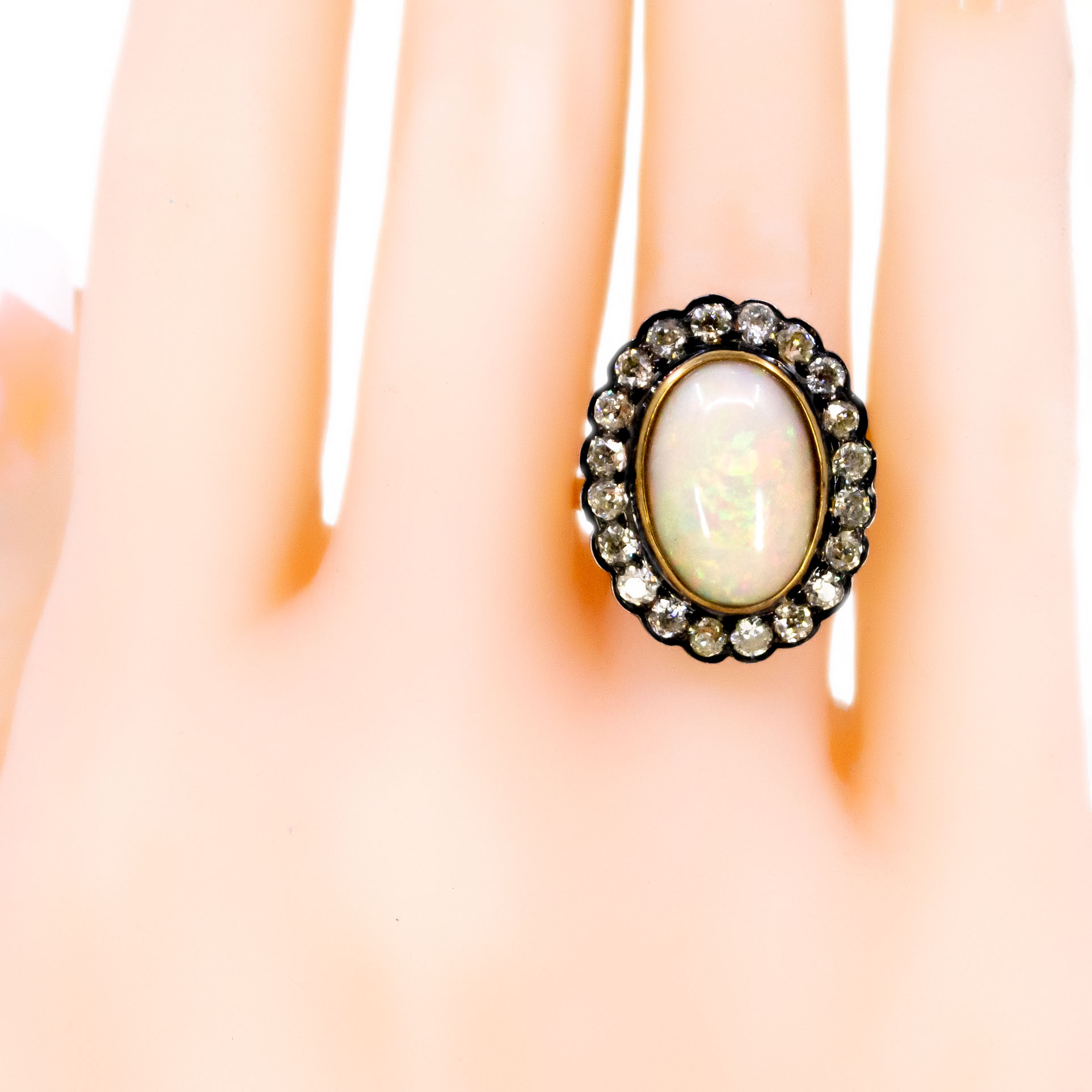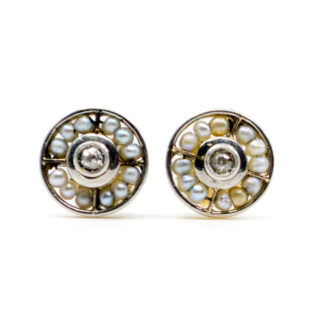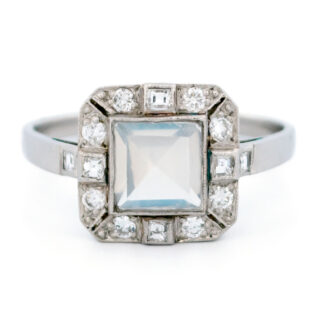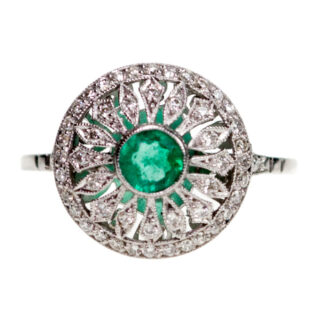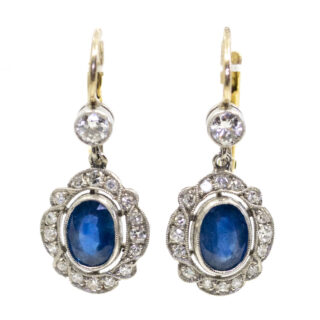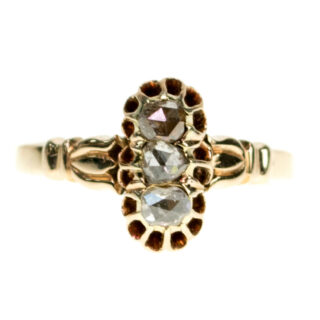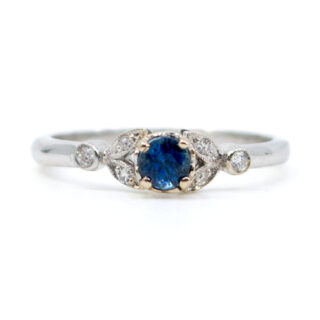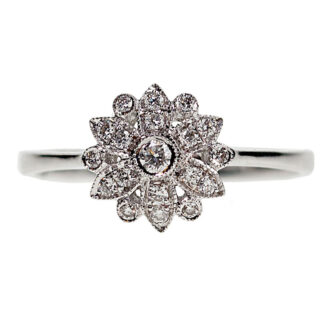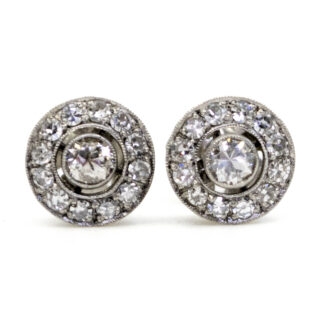This vintage Victorian-style ring is truly stunning, with an beautiful cluster design. The center of the ring features a cabochon-cut opal weighing approximately 6.50 carats, surrounded by a halo of approximately 1.10 carats of K SI1 old mine cut diamonds. The ring is made of a combination of 14k gold and silver, which adds to its vintage charm and elegance.
Details: ±6.50ct Opal, ±1.10ct (K SI1) Old-mine-cut diamonds, 14k, Silver Ring.
Design Era: Vintage Victorian.
Size: 17.93 NL / 56.3 FR / 7¾ US / P UK.
Dimensions: H 0.9 x L 1.8 x W 2.3 cm.
Weight in grams: 5.7.
Condition: Very good condition – slightly used with small signs of wear.
Shipping and Pickup: This exquisite piece ships from our store located in the center of Amsterdam, The Netherlands. We offer both registered shipping and local pickup at our store. In the case of local pickup, any applicable shipping costs will be refunded.
About Us: Add some sparkle to your style with Binenbaum.com. We offer a stunning selection of antique and vintage jewelry that you won’t find anywhere else. From timeless rings and dazzling necklaces to unique brooches, we have something for every taste and occasion. Visit our website today and treat yourself to a piece of history.
| Design Era | |
|---|---|
| Design & Historical Context | The Victorian Era was a time of great cultural and artistic flourishing in England, and this was reflected in the jewelry of the time. During the Victorian Era, a middle class began to emerge, which sparked a demand for jewelry in the mass market. Jewelry trends during this time often reflected the tone of current events. The Victorian Era is usually divided into three subsections: the Romantic Period (1837-1861), the Grand Period (1861-1880), and the Aesthetic Period (1880-1901). During the Romantic Period, jewelry featured nature-inspired designs similar to those of the Georgian era, and was characterized by its intricate and delicate detailing. Lockets and brooches were popular for daytime wear, while colored gemstones and diamonds were worn in the evening. During the Grand Period, known as the Mid-Victorian era, jewelry was often influenced by the death of Queen Victoria's husband. Many jewelry pieces from this period have solemn, somber designs and feature heavy, dark stones such as jet, onyx, amethyst, and garnet. This period also saw the emergence of highly creative, colorful designs using shells, mosaics, and gemstones. During the Aesthetic Period, jewelers used diamonds and feminine, bright gemstones such as sapphire, peridot, and spinel. Star and crescent designs, as well as elaborate hat pins, were also popular. Some scholars believe that the Aesthetic Period began earlier, in 1875, and ended as early as 1890. |
| Key Materials | |
| Materials & Craftsmanship | Opal Opal is a gemstone that is known for its unique and stunning appearance. It is composed of microscopic cristobalite spheres arranged in layers within an amorphous hydrous silica jelly, which gives it its unique crystal habit. One of the most striking features of opal is its play-of-color, which is the way that light is refracted by the microscopic spheres within the gemstone. This refraction creates an array of vivid colors, ranging from red and orange to yellow, green, blue, and purple. The play-of-color is what makes opal such a beautiful and desirable gemstone, and it is one of the main reasons that it is so highly prized. There are many different types of opal, including black opal, white opal, and fire opal. Black opal is the most valuable and sought-after type, as it has the most intense play-of-color. White opal is less valuable, but it is still prized for its beauty and is often used in jewelry and other decorative objects. Fire opal is a type of opal that is characterized by its deep orange or red color and is often used in jewelry. Opal is found in a few different locations around the world, including Australia, Mexico, and the United States. It is a relatively soft and brittle gemstone, and it requires careful handling and protection to preserve its beauty. Despite its delicate nature, opal is a popular and highly valued gemstone that is used in a wide range of jewelry and decorative objects. Old-mine-cut diamond The old mine cut is a type of diamond cut that was popular in the 1700s and was most prevalent during the Georgian and Victorian eras. It is similar to today's cushion cut and is characterized by a squarish girdle with gently rounded corners, a high crown, a small table, and a large, flat culet. Old mine cut diamonds are known for their antique charm and character, and they are often used in vintage-style jewelry. They have a softer, more romantic look than modern diamond cuts, which tend to have more precise geometry and a higher level of brilliance. Old mine cut diamonds are typically less expensive than diamonds with more modern cuts because they require less labor and material to produce. They are often used as accent stones in jewelry designs or as the main gemstone in vintage-style pieces. Despite their lower price, old mine cut diamonds can still be beautiful and valuable, and they are a popular choice for those who appreciate the unique charm and character of antique jewelry. 14k 14k gold is a popular choice for use in jewelry because it is durable, yet still relatively affordable compared to higher karat golds like 18k or 24k. It is made up of 58.5% pure gold and is mixed with other metals to make it harder and more durable. 14k gold is available in a range of colors, including yellow, white, and rose, and is commonly used in a variety of jewelry pieces such as rings, earrings, necklaces, and bracelets. One of the advantages of 14k gold is that it is more resistant to wear and tear than pure gold, which makes it suitable for everyday wear. However, it is still softer than other alloys such as stainless steel or platinum, so it may require more maintenance to keep it looking its best. Overall, 14k gold is a popular choice for those who want the look and feel of gold, but at a more affordable price point. Silver Silver is a white metallic element that is known for its excellent conductivity of heat and electricity. It is represented on the periodic table of elements by the symbol Ag, and it is a member of the noble metals, which are known for their excellent resistance to oxidation. Silver is a relatively soft metal, with a hardness that is intermediate between gold and copper. It is more malleable and ductile than gold, which means that it can be easily shaped and molded into various forms. However, it is not as hard as copper, which means that it is more prone to scratches and other types of damage. Because of its softness, silver is usually alloyed with another metal to harden it enough to maintain the desired shape and details when it is used in jewelry and other decorative objects. This helps to give it the necessary strength and durability for use in these types of applications. Throughout history, silver has played a prominent role in the production of jewelry and objets d'art. It is prized for its beauty and versatility, and it is often used in a wide variety of different types of jewelry, including rings, earrings, pendants, and bracelets. It is also used in decorative objects, such as candlesticks, vases, and other decorative items. |
| Size | |
| Dimensions | H 0.9 x L 1.8 x W 2.3 cm |
| Gender | |
| Weight (in grams) | 5.7 |
| Condition | Very good condition – slightly used with small signs of wear |
Enhance the Beauty of Your Jewelry with Proper Care
Wearing your jewelry is a special way to express yourself and add a touch of personal style to any look. However, to ensure your jewelry remains in pristine condition, there are a few simple steps you need to take to keep it looking its best.
General Care Instructions:
Remove jewelry when showering or bathing, especially when at the beach, in the sea or in chlorinated water.
Avoid wearing jewelry while doing physical work such as housekeeping, gardening or exercise.
Storing your jewelry in a dry and cool place will help protect it from moisture, dirt and dust.
Keeping it away from harsh chemicals such as bleach, ammonia and chlorine will help to avoid discoloration and damage.
Cleaning your jewelry regularly with a soft cloth will help to keep it looking shiny and new.
Avoid exposing your jewelry to extreme temperatures, such as leaving it in direct sunlight or near a heater, as this can cause damage.
Handle your jewelry carefully and avoid dropping it, as this can cause the stones to loosen or the metals to scratch.
Finally, if possible, have your jewelry professionally checked and serviced. This will ensure that any potential problems are spotted and fixed before they become worse.
By following these tips, you can enjoy your precious jewelry for many years to come.
Related products
-
Diamond Pearl 18k Cluster Earrings 8277-1998
€ 695,00 VAT incl. (where applicable) -
Moonstone Diamond Platinum Square-Shape Ring 4489-4682
€ 2.995,00 VAT incl. (where applicable) -
Emerald Diamond Platinum Cluster Ring 6903-4869
€ 2.995,00 VAT incl. (where applicable) -
Diamond Sapphire Platinum 18k Pendant Earrings 4503-4685
€ 3.795,00 VAT incl. (where applicable) -
Diamond 14k Vertical Trilogy Ring 8259-1984
€ 1.395,00 VAT incl. (where applicable) -
Sapphire Diamond 18k Ring 5072-4669
€ 1.695,00 VAT incl. (where applicable) -
Diamond 18k Cluster Ring 7035-0694
€ 1.395,00 VAT incl. (where applicable) -
Diamond Platinum Cluster Earrings 4977-4675
€ 3.395,00 VAT incl. (where applicable)
- Home
- Collection
- Fine Jewelry
- Silver Jewelry
- Silverware
- Boxes
- Candlesticks
- Salt and pepper shakers
- Miniatures
- Salt cellars
- Spoon Set
- Condiments
- Frames
- Napkin Ring
- Spoon
- Oddities
- Cups
- Vases
- Cutlery
- Serving Spoon And Cake Server
- Candlesticks
- Baskets
- Hanukkiah
- Spice Tower
- Yad
- Tea Set
- Sugar Castor
- Napkin Rings
- Wine Bottle Coaster
- Wine Stopper
- Tea Pot
- Jugs
- Rattles
- Hip Flask
- Miscellaneous
- Rings 💍
- About
- Contact



